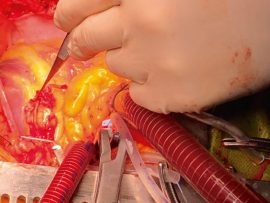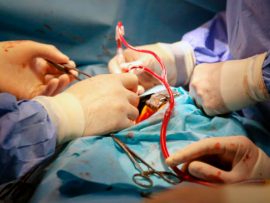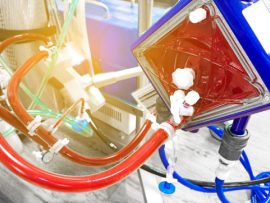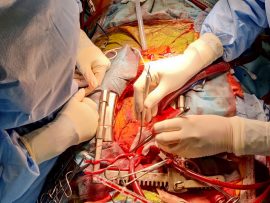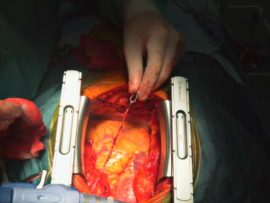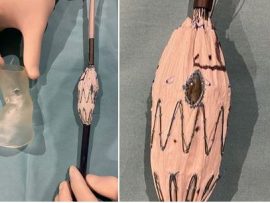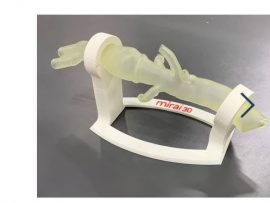ABSTRACT This study investigated the diagnostic value of urinary interleukin-18 (uIL-18) in acute kidney injury (AKI) after cardiopulmonary bypass (CPB) in clinical practice. A total of 103 patients who underwent..
Read MoreAbstract Prostacyclin (prostaglandin I2 [PGI2]) is an eicosanoid lipid mediator produced by the endothelial cells. It plays pivotal roles in vascular homeostasis by virtue of its potent vasodilatory and antithrombotic effects...
Read MoreAbstract Background: Several clinical trials have documented clinical benefits associated with prophylactic corticosteroid administration at the time of coronary artery bypass graft (CABG) surgery, including a reduction in the risk..
Read MoreAbstract Objective As with any biomarker, interpretation of changes of concentration must consider its variability in a specific clinical setting. The aim of this study was to calculate the reference change..
Read MoreAbstract Background Postoperative cognitive dysfunction (POCD) is a common complication of cardiac surgery. Studies have identified potentially injurious roles for cardiopulmonary bypass (CPB) and subsequent reperfusion injury. Cognitive dysfunction has..
Read MoreAbstract Objective We studied patients who had experienced a stroke in the postoperative period of cardiac surgery, aiming to analyse their progression and determine the factors that may influence prognosis..
Read MoreAbstract OBJECTIVES Organ protective management during aortic arch surgery comprises deep hypothermic (18°C) circulatory arrest (DHCA), or moderate hypothermia (28°C/ ‘tepid’) with regional cerebral perfusion (TRCP). The aim of this..
Read MoreABSTRACT Background: Blood transfusions are the most common type of tissue and organ transplantation. Perioperative and postoperative transfusions may cause morbidity and mortality and transfusion should based on only hematocrit values..
Read MoreAbstract Postcardiotomy cardiogenic shock (PCCS) is a rare but catastrophic syndrome that can occur following separation from cardiopulmonary bypass or at any time during the immediate postoperative course. The management..
Read MoreAbstract Objective: Cardiopulmonary bypass (CPB) and deep hypothermic circulatory arrest (DHCA) are commonly used in cardiac surgery. However, the mortality and morbidity are still high in practice. Developing novel protective..
Read MoreAbstract Background Adhesions encountered during reoperative cardiac surgery can prolong operative time and increase operative risk. The purpose of this clinical study was to investigate the antiadhesion property of a..
Read MoreAbstract The use of venovenous extracorporeal membrane oxygenation is increasing worldwide. These patients often require noncardiac surgery. In the perioperative period, preoperative assessment, patient transport, choice of anesthetic type, drug..
Read MoreAbstract Objective To explore how organizations respond to and interact with the accreditation process and the actual and potential mechanisms through which accreditation may influence quality. Design Qualitative grounded theory..
Read MoreAbstract OBJECTIVES The public health care system in Brazil has extensive waiting lists of patients requiring complex operations such as coronary artery bypass grafting (CABG). The purpose of this study..
Read MoreAbstract OBJECTIVES Left-sided unloading during extracorporeal membrane oxygenation (ECMO) therapy is crucial to prevent pulmonary oedema and facilitate ventricular recovery. We present the case of a 55-year-old man under ECMO..
Read MoreAbstract A heparin-specific binding peptide was conjugated to a cowpea chlorotic mottle virus (CCMV) capsid protein, which was subsequently allowed to encapsulate heparin and form capsid-like protein cages. The encapsulation..
Read MoreAbstract Cardiovascular diseases are the leading cause of mortality worldwide, responsible for nearly 18 million deaths each year. More than 80% of these take place in low- and middle-income countries..
Read MoreAbstract Heart disease is the leading cause of death in men and women in the United States. During the past several decades, research into the role of specific intracellular mediators,..
Read MoreAbstract Objective Hemolysis, characterized by formation of free hemoglobin (Hb), occurs in patients undergoing cardiopulmonary bypass (CPB). However, there is no study of the dynamic changes in red blood cell..
Read MoreAbstract Aim A typical adult based bivalirudin regimen during cardiopulmonary bypass uses a loading dose of 1 mg.kg‐1 and a circuit prime (volume L x 13 mg) with a subsequent intravenous..
Read MoreAbstract Measurements of transcutaneous carbon dioxide (tcCO2) have been used in multiple venues, such as during procedures utilizing jet ventilation, hyperbaric oxygen therapy, as well as both the adult and..
Read MoreAbstract Introduction Paediatric patients are particularly prone to cardiopulmonary bypass (CPB)‐induced coagulopathy mainly due to haemodilution, consumption of coagulation factors and hypothermia. The aim of the present study was to..
Read MoreAbstract The need for the estimation of the number of microbubbles (MBs) in cardiopulmonary bypass surgery has been recognized among surgeons to avoid postoperative neurological complications. MBs that exceed the..
Read MoreAbstract As New York State quickly became the epicenter of the COVID-19 pandemic, innovative strategies to provide care for the COVID-19 negative patients with urgent or immediately life threatening cardiovascular..
Read MoreA partir de la utilización de impresión 3D, el paciente recibió una respuesta rápida para tratar su patología y fue intervenido con éxito en un procedimiento rápido, efectivo y preciso...
Read MoreUtilizar un modelo 3D para crear la prótesis endovascular a medida le permitió al equipo quirúrgico reducir el tiempo total de la intervención y además generó un ahorro de insumos...
Read MoreLa reconstrucción virtual fue de suma utilidad para reconocer fácilmente las estructuras y sus límites debido a los marcadores de color.
Read MoreLa simulación es una actividad de relevancia ya que provee una manera de aprender procedimientos dentro de un ambiente controlado, brindando protección y mayor seguridad para los pacientes.
Read MoreEn este reporte se analizarán dos casos de alta complejidad y muy similares entre si de dos pacientes pediátricos con cardiopatías congénitas.
Read MoreDespite the critical role of cytokines in the modulation of the immune response, cytokine hyperactivity has been implicated in the pathogenesis of severe organ failure secondary to sepsis, cardiac surgery,..
Read More


